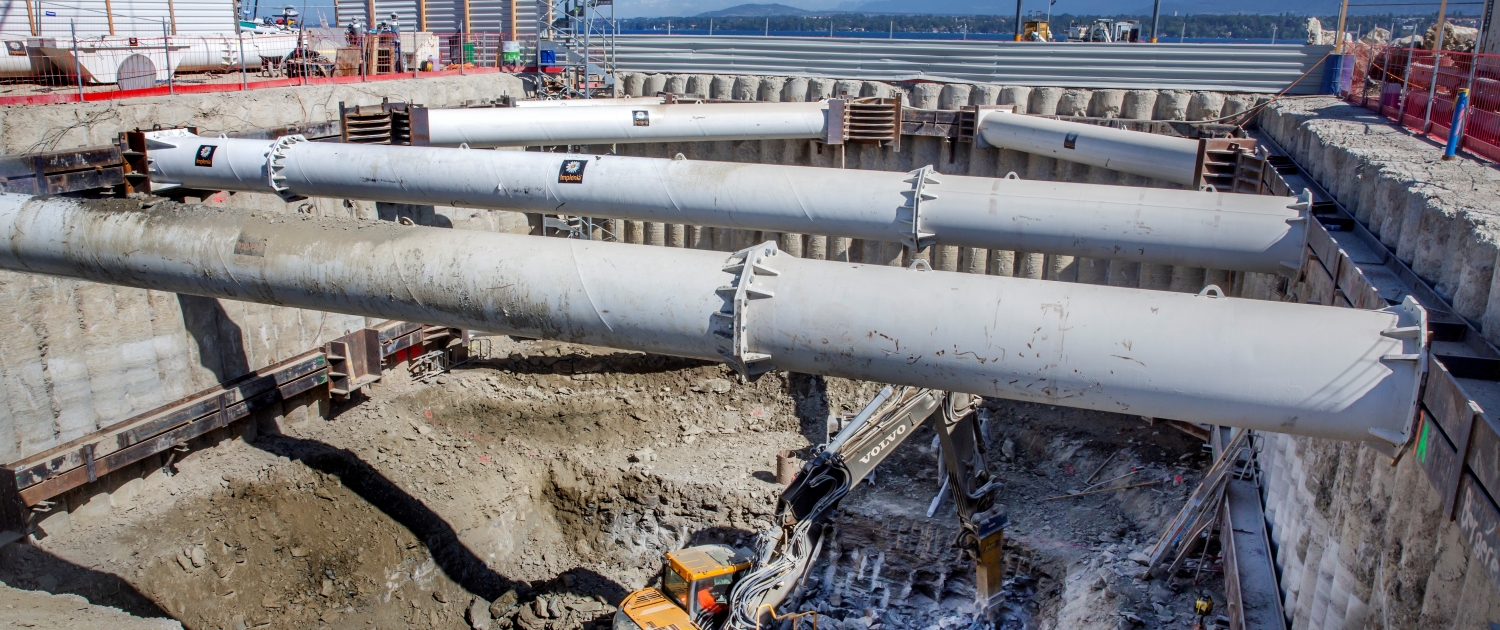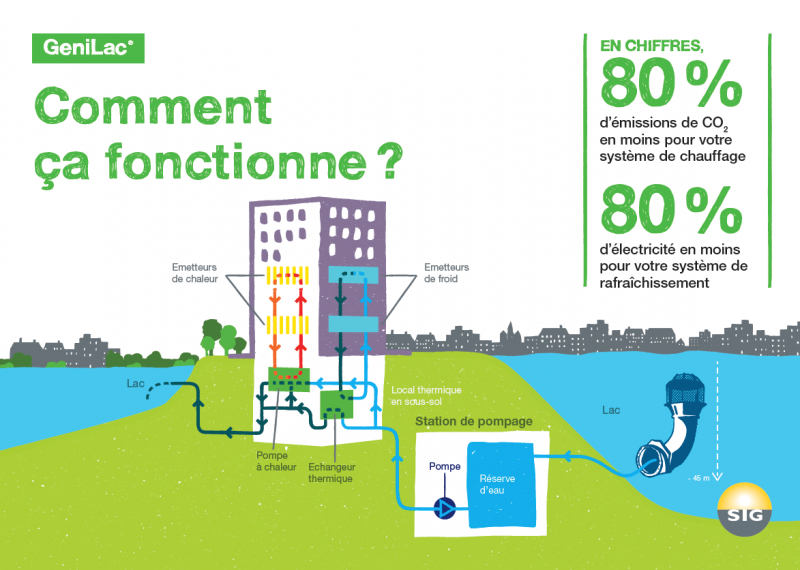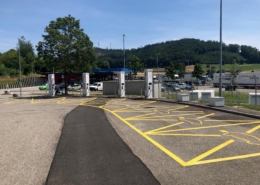Water can also heat
...and cool. If around 300 buildings in the canton of Geneva were heated and cooled with water from Lake Geneva, this could save around 70,000 tonnes of CO2 emissions per year.
In Geneva, the focus is on district heating - with increasingly sophisticated networks and systems. The implementation of the latest project is currently gathering pace: GeniLac is a 30-kilometre district heating network that will be used to heat and cool the region with water from Lake Geneva. With the principle of district heating or district cooling, buildings can be heated and cooled without having to burn fossil fuels. Air conditioning systems and oil or gas boilers are being replaced and the Canton of Geneva is one step closer to its goal of reducing fossil fuel consumption by 39% by 2023. Services Industriels de Genève (SIG) was commissioned to plan and implement this major project.
Until the water flows back into the lake
The GeniLac pipeline network forms a closed circuit. To bring the water on its way through the canton, it is sucked in at a depth of 45 metres at an average temperature of around 7° C. A dirt filter prevents foreign bodies from entering the pipe system. From there it is piped to the pumping station in Vengeron on the left bank of the lake just outside the city centre. The new pumping station required for this alone accounts for CHF 100 million of the total budget. The plant is located 17 metres underground and is equipped with ten powerful pumps. From here, the water finds its way into households and commercial buildings via the network of underground pipes. To close the cycle, the water is finally returned to Lake Geneva. Here, SIG adheres to strict regulations with regard to water quality and temperature. A possible temperature change of the lake in summer is estimated at a maximum of 0.16 degrees.
GeniLac is the largest hydrothermal network in Geneva
But the project is not created on white paper. Ten years ago, a smaller hydrothermal network was put into operation, which already cools the UN, the ICRC and other institutions. With GeniLac, the Geneva-Lac-Nations (GLN) project is now being expanded on a grand scale. In this way, existing resources can be built on and the experience gained increases the success rate of the new project.
The project was launched in 2015 and currently comprises ten buildings connected to the city centre. Three kilometres of lines have already been laid to date, representing 10 percent of the entire network. Onshore construction work for the Vengeron pumping station began in February 2019 and should be completed by 2022.
Integrated building
In order to minimize the impact on the environment and emissions caused by the laying of 30 kilometers of pipeline, the construction work for GeniLac is being coordinated with other major construction projects. At the airport, for example, high-voltage lines will be buried in the next few years anyway and a motorway feeder road will be built. For this reason, the lines leading into the airport area are being laid at the same time. In addition, the environmental damage caused by the construction of the pumping station in Vengeron is being compensated for by various measures. For every tree that has to be felled because of a construction site, a new one of a native species is planted. In addition, a bird island and a 1500m2 reed bed will be created on the lakeside.
Around 300 buildings connected to GeniLac
GeniLac will in future supply the city center and various areas of Geneva with district heating and cooling respectively. Exactly how many buildings will be connected to the network is still difficult to assess today, because the network will also lead to new housing estates that are not yet planned in detail. Roughly speaking, however, SIG assumes that there will be around 300 buildings. Ten buildings are already connected to the current network, including premises of Crédit Suisse, Swisslife and the Biotech Campus. In terms of use, a distinction must be made between commercial or public buildings and private households: In the canton of Geneva, air conditioning systems may only be used in business premises. Air conditioning in apartments is prohibited.
However, for a building to be connected to the grid at all, a number of conditions must be met. In principle, only new or renovated buildings are compatible with GeniLac. Since 2010, such buildings have been obliged under Geneva legislation to obtain at least one third of their heating energy from renewable sources. To heat with GeniLac, the building must have a heat pump. A heat exchanger is needed for cooling. For the customers this results in certain costs and also the operation with clean energy is currently for most variants still somewhat more expensive than with fossil energy.
Operation with Vitale Bleu
The sustainability of the project is not limited to the production and origin of the energy, but is also taken into account in the operation of the plant. Six pumps with 700 kW and four with 220 kW are powered by electricity generated by SIG from 100 percent renewable energy, the so-called Vitale Bleu. In order to ensure the highest possible efficiency, the machines also operate at different levels of intensity, depending on the requirements.
As a result of these measures, SIG envisages that its customers will be able to reduce their electricity requirements by as much as 80 per cent when generating cooling and that CO2 savings of 80 per cent will also be possible when heating. In this way, a total of up to 70,000 tonnes of CO2 can be saved by 2035, which corresponds to the annual heating emissions of around 7,000 people in Geneva. The canton of Geneva is thus moving towards a 2000-watt society.
Laura Scheiderer, Communication Energy role model Bund, Polarstern
Pictures: SIG
ENERGY ROLE MODEL
From 2006 to 2020, the Federal Council wants to increase energy efficiency within the federal administration and in companies close to the federal level by 25 %. The players involved (including cantonal public companies since 2017) plan and coordinate some of their measures within the framework of the Energy Model Initiative. Its action plan comprises 39 joint measures in three areas of action (buildings and renewable energy, mobility and data centres and green IT) plus a series of specific measures that each actor defines individually. At present, the following actors are among them: Swiss Post, ETH Domain, Geneva Airport, SBB, SIG, Skyguide, Suva, Swisscom, DDPS and the Federal Civil Administration. In each issue of Phase 5, Energie-Vorbild presents ideas and projects on how to further increase energy efficiency and the share of renewable energy. www.energie-vorbild.admin.ch
 SIG
SIG



 ShutterstockThe new Energy-Economy-Society call is online!
ShutterstockThe new Energy-Economy-Society call is online!  Benedickt VogelStabiles Stromnetz dank tieferer Absicherung
Benedickt VogelStabiles Stromnetz dank tieferer Absicherung  EnergieSchweizSilvan Dillier: «Wir sollten zur Welt Sorge tragen»
EnergieSchweizSilvan Dillier: «Wir sollten zur Welt Sorge tragen»  BFENeue Kennzahlen zeigen, wie der Ausbau des öffentlichen Ladenetzes für E-Autos läuft
BFENeue Kennzahlen zeigen, wie der Ausbau des öffentlichen Ladenetzes für E-Autos läuft 
 BFE
BFE Shutterstock
Shutterstock
Sehr interessantes Projekt! Mich würde zusätzlich der genaue Aufbau des Pumpwerks interessieren. Wird im ganzen System wirklich Seewasser gefördert oder gibt es eine Systemtrennung im Pumpwerk? Denke dieser Punkt ist doch noch sehr wichtig, da er die Kosten bezüglich Materialisierung und auch der Wartung exponentiell beeinflusst. Denke hier sollte der Trend definitiv zur Systemtrennung im Pumpwerk gehen um die Systeme auch langlebig, kostengünstig und wartungsfreundlich zu gestalten.
Ein intelligentes Projekt. Hoffentlich funktioniert es, obwohl die „pompe“ im Bild „Comment ça fonctionne?“ in die falsche Richtung fördert.
Die Wärmepumpen entdeckt nur, wer sich in den Text vertieft, und die sind zentral. Dieses Versteckspiel ist irreführend.